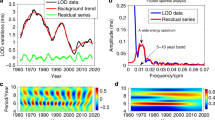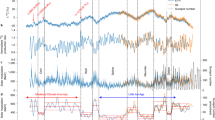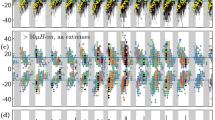Abstract
Arising from: S. K. Solanki, I. G. Usoskin, B. Kromer, M. Schüssler & J. Beer Nature 431, 1084–1087 (2004); Solanki et al. reply.
To put global warming into context requires knowledge about past changes in solar activity and the role of the Sun in climate change. Solanki et al.1 propose that solar activity during recent decades was exceptionally high compared with that over the preceding 8,000 years. However, our extended analysis of the radiocarbon record reveals several periods during past centuries in which the strength of the magnetic field in the solar wind was similar to, or even higher than, that of today.
This is a preview of subscription content, access via your institution
Access options
Subscribe to this journal
Receive 51 print issues and online access
$199.00 per year
only $3.90 per issue
Buy this article
- Purchase on Springer Link
- Instant access to full article PDF
Prices may be subject to local taxes which are calculated during checkout


Similar content being viewed by others
References
Solanki, S. K., Usoskin, I. G., Kromer, B., Schüssler, M. & Beer, J. Nature 431, 1084–1087 (2004).
Beer, J. Space Sci. Rev. 93, 107–119 (2000).
McCracken, K. G. & Heikkila, B. in Proc. 28th Int. Cosmic Ray Conf. 2003, Tsukuba, Japan 4117–4120 (Univ. Acad. Press, Tokyo, 2003).
Stuiver, M., Reimer, P. J. & Braziunas, T. F. Radiocarbon 40, 1127–1151 (1998).
McCormac, F. G. et al. Radiocarbon 44, 641–651 (2002).
Siegenthaler, U. J. Geophys. Res. 88, 3599–3608 (1983).
Joos, F. et al. Tellus B 48, 397–417 (1996).
Masarik, J. & Beer, J. J. Geophys. Res. 104, 12099–12111 (1999).
Yang, S., Odah, H. & Shaw, J. Geophys. J. Int. 140, 158–162 (2000).
Gerber, S. et al. Clim. Dynam. 20, 281–299 (2003).
Bard, E., Raisbeck, G. M., Yiou, F. & Jouzel, J. Tellus B 52, 985–992 (2000).
Muscheler, R., Beer, J., Kubik, P. W. & Synal, H. -A. Quat. Sci. Rev. 24, 1849–1860 (2005).
Snowball, I. & Sandgren, P. Earth Planet. Sci. Lett. 227, 361–376 (2004).
Francey, R. J. et al. Tellus B 51, 170–193 (1999).
Hoyt, D. V. & Schatten, K. H. Solar Phys. 179, 189–219 (1998).
Author information
Authors and Affiliations
Corresponding author
Rights and permissions
About this article
Cite this article
Muscheler, R., Joos, F., Müller, S. et al. How unusual is today's solar activity?. Nature 436, E3–E4 (2005). https://doi.org/10.1038/nature04045
Published:
Issue Date:
DOI: https://doi.org/10.1038/nature04045
This article is cited by
-
Holocene vegetation patterns in southern Lithuania indicate astronomical forcing on the millennial and centennial time scales
Scientific Reports (2019)
-
Evolution of the Sunspot Number and Solar Wind B $B$ Time Series
Space Science Reviews (2018)
-
A history of solar activity over millennia
Living Reviews in Solar Physics (2017)
-
An Antarctic view of Beryllium-10 and solar activity for the past millennium
Climate Dynamics (2011)
-
Forecast of the Decadal Average Sunspot Number
Solar Physics (2008)
Comments
By submitting a comment you agree to abide by our Terms and Community Guidelines. If you find something abusive or that does not comply with our terms or guidelines please flag it as inappropriate.



